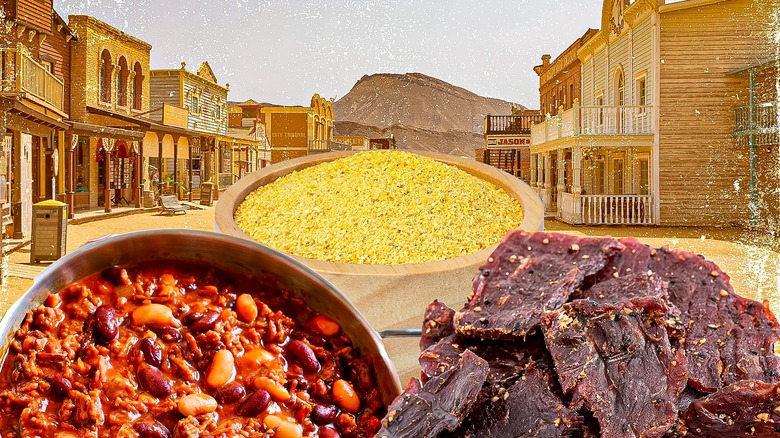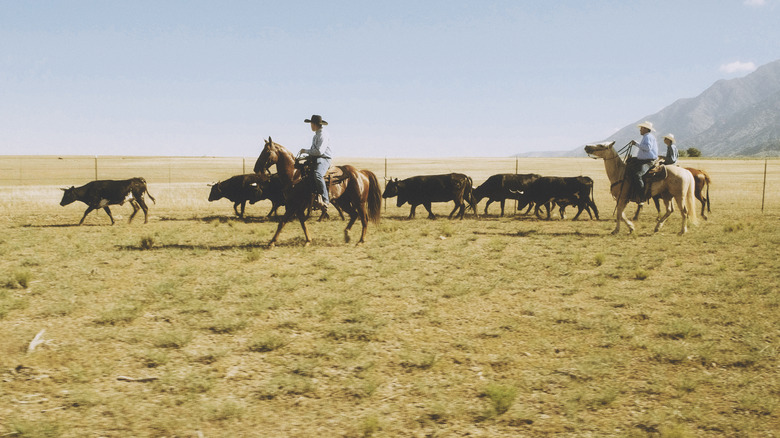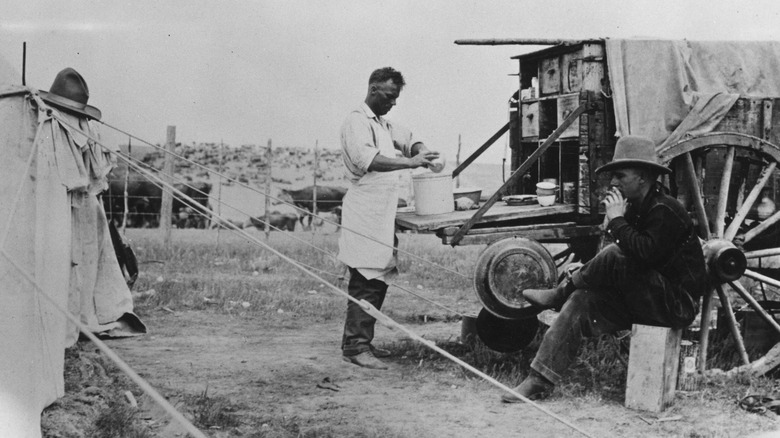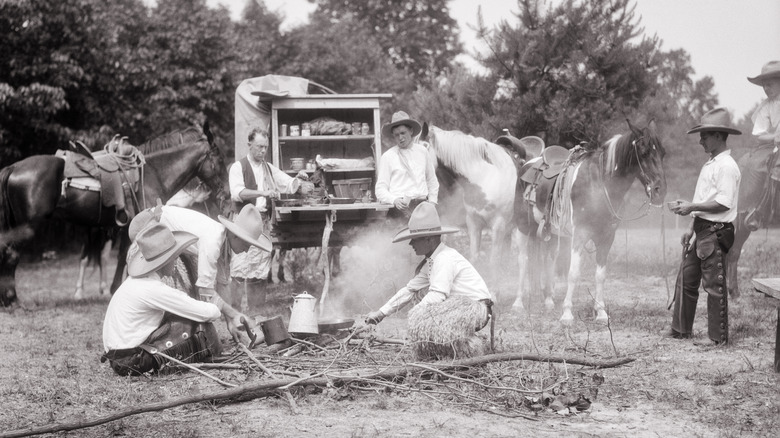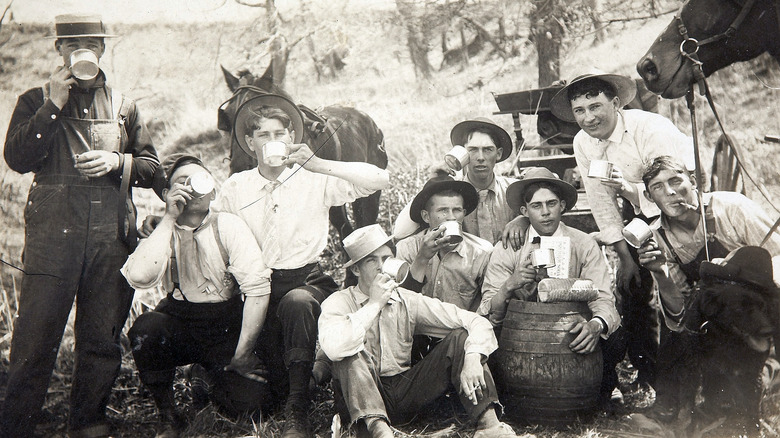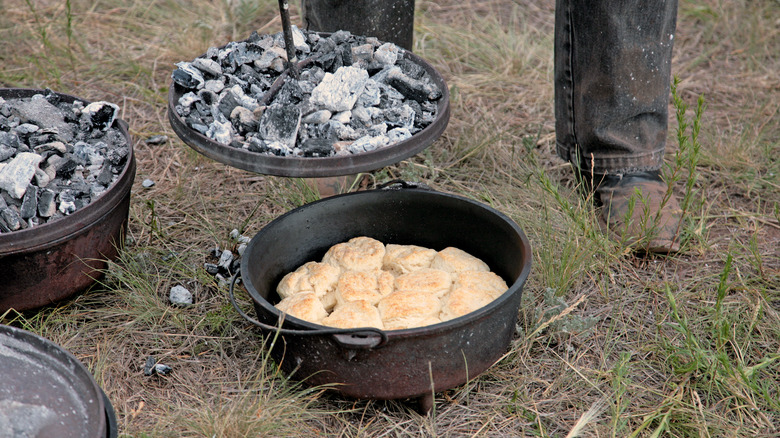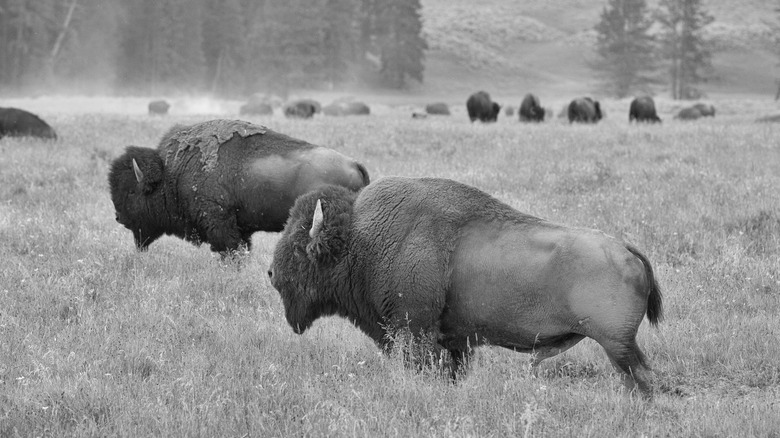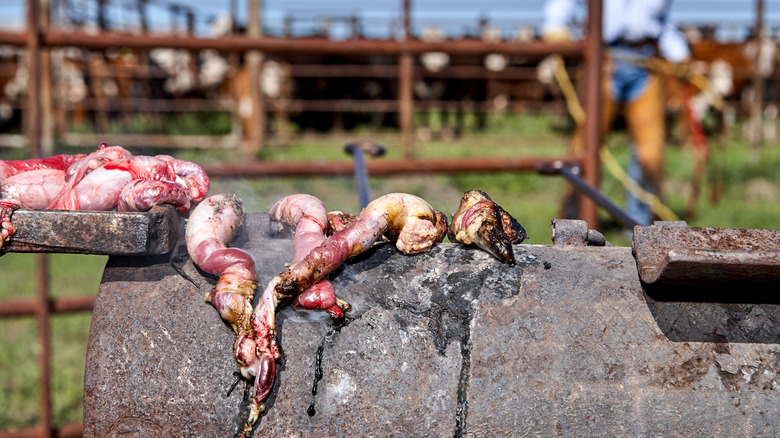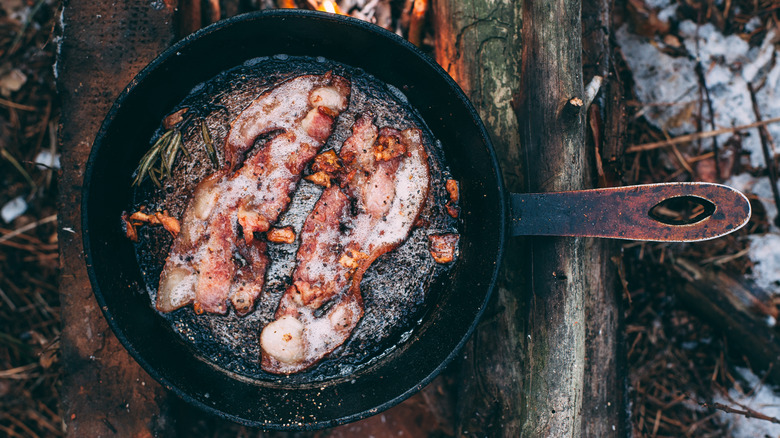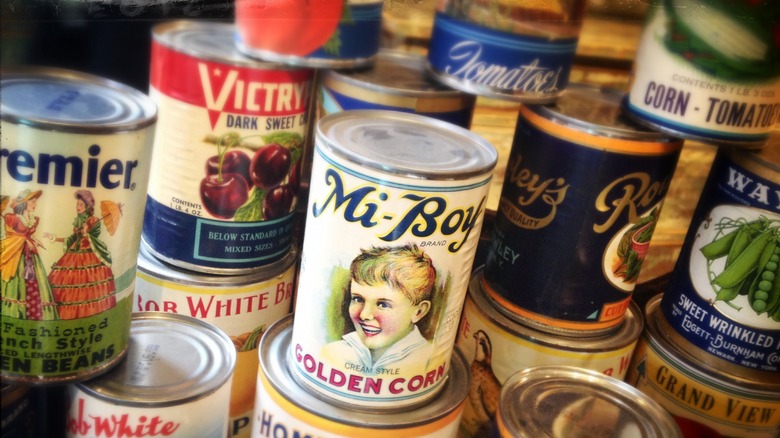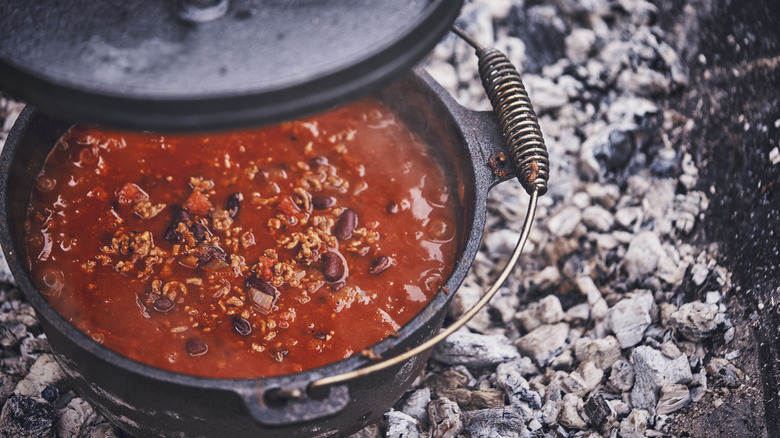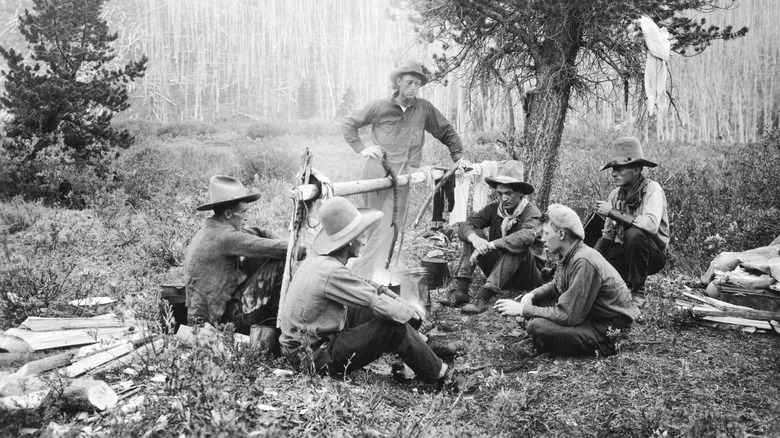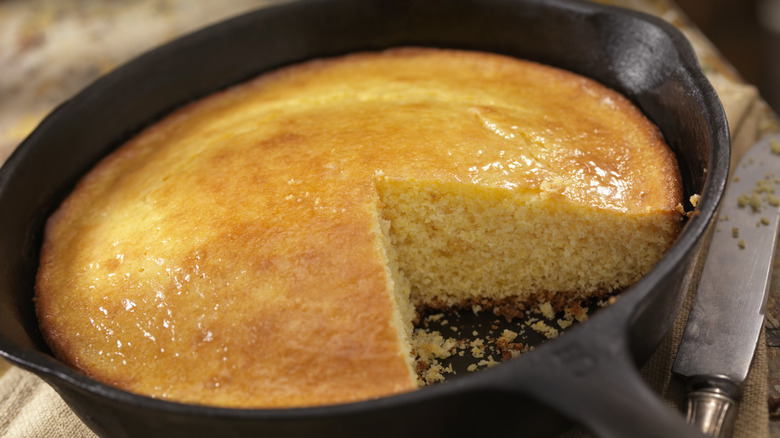What Did A Typical Cowboy Diet Consist Of In The Old West?
Cowboy diet and lifestyle took inspiration from the peoples that had been working the land long before Americans started moving west. Living in a time before refrigeration, cowboys relied on ingredients that could last for months — or even years — without spoiling, and consequently borrowed many Native American food preservation methods. While foraging along the trail for herbs, berries, and even bird eggs was common practice, there were many staples cowboys packed with them. If they weren't elegant, meals on the trail were certainly hearty, since they had to keep herding crews going for long, arduous, dusty days full of exertion.
Cowboys also took cultural and culinary inspiration from Mexican vaqueros. Experts at herding cattle long before settlers ventured west, vaqueros developed many of the tools necessary for the trade, like chaps and lassos, and in the early days of the west, trained many cowboys-to-be. Having herded cattle for hundreds of years, these skilled horsemen were veterans of living and cooking on the move. Recipes for their wholesome fare were another of the many things cowboys adopted directly from the vaquero lifestyle.
As for what cowboys actually did eat, Dr. Richard W. Slatta, professor emeritus of history at North Carolina State University, recounts one concise summary of Old West fare as described by Oklahoma cowboy Puny Martin, "Beef, beans, taters. That's what you had to have." Some cowboys were lucky to have a little more variety than that while on cattle drives, but options were still fairly limited.
Cows made the cowboy
The role of the cowboy developed alongside the formation of a ranching economy in the Americas, which is an industry with colonial roots. Spanish settlers brought cows across the Atlantic on some of the first ships that berthed in the New World, and cattle rearing was especially successful in the Southwest, in parts of Mexico and Texas, where vaqueros reigned.
Texas became the hotspot for a cattle industry, though before the Civil War, cattle were raised more for their skin and fat than their potential as a meat source. Their hide was used to make leather — a versatile material — though their fat had even more adaptability once boiled into tallow, which, as a malleable substance, had many potential uses. These uses included cooking, making soap, and molding into candles — an especially important commodity in a world that hadn't yet discovered electricity.
The advancement of railroad networks around the same time as the Civil War created a convenient means of supplying a growing demand for meat, and the wide ranges and open prairies of the American West were ideal locations for raising cattle. This culmination of innovation and consumption in the mid-19th century set the stage for the cowboy to become an important figure in the American economy and the subsequent push west.
Chuckwagon fare changed the cowboy diet
In the early days of the West, cowboys only ate whatever they could carry in their saddlebags or kill on site. But as a demand for beef grew with a growing and migrating population seeking gold and manifest destiny, the skeleton crews that had previously worked with cattle grew into large-scale operations to accommodate a rapidly expanding industry.
The cowboys' job, as their name suggests, was to herd cattle, a rough and unrewarding occupation that entailed pushing large herds on cattle drives from middle-of-nowhere ranches to central markets, auctions, or railroad depots, where cows would be sold and transported. Passing through vast expanses of wild lands, there was nowhere to sleep or eat but under the open sky. This job came with no Old West glamor, but camping overnight took on a bit of home comfort with the introduction of the chuckwagon.
Attributed to Charles Goodnight, this mobile kitchen and pantry consisted of a revamped army supply wagon that would travel alongside the cowboys on the cattle trail. Equipped with cast iron kettles, pans, and dutch ovens, and pulled by a team of up to six oxen, the chuckwagon didn't travel light, but it made fresh, hot meals possible. This home-cooked chuck (the Cowboy Glossary's term for "food") was a big step up from the preserved stuff cowboys previously relied on. Dining together in the afternoons and evenings en plein air, cowboys could enjoy more camaraderie, and hearty fare made for happier workers.
The cook made the team
Perhaps in the humor of the cowboys' rough and tumble ways, they had many names of reverence for the cook who rounded out their crew. "Cookie" was a popular appellation, but Dr. Slatta, suggests many more inventive names made their way into the cowboy lexicon, such as "bean master, pot rustler, biscuit shooter, dough puncher, grub slinger, [and] coosie (from the Spanish term for cook, cocinero)." Cooks earned cowboys' respect beyond their wholesome grub by keeping longer days than the cowboys themselves. They woke up the earliest to prepare breakfast for their team, and were always on the job. As soon as one meal was through, the cook would move on to a new location to set up the kitchen again for the next meal. "Dinner" was lunchtime, and "supper" was in the evening.
But despite their required culinary aptitude in efficiently working wonders to keep meals interesting with limited ingredients, cooks on the cattle trail wore many more than a mere chef's hat. They also carried first aid supplies in the chuckwagon, taking on the unofficial role of doctor or veterinarian when duty called. Because they kept a cattle crew going, the title of cook was a position of esteem and influence; accordingly, cooks were paid higher than cowboys. A good cook could make a cattle drive a success, just as a bad cook might deter cowboys from seeking work with a particular ranch.
Coffee was taken strong and barefooted
Coffee was a daily necessity in the West, but because green coffee beans kept best, whipping up a simple brew on the trail wasn't exactly simple. Beans had to be roasted and ground first — that is, until two enterprising upstarts started supplying roasted and even pre-ground coffee. While James A. Folger dominated the market of gold miners along the west coast, John Arbuckle Jr. invented the brand that fueled the frontier. Arbuckle's innovation for preserving coffee beans included a trick that gave them superior flavor too. HistoryNet explains that while roasting the beans, he coated them with a mixture of sugar, eggs, and Irish moss, making Arbuckle's blend so popular his name became interchangeable with coffee itself.
Coffee was an obligatory tool in the cowboy's arsenal, an essential pick-me-up for a job that necessitated early mornings, long days, and frequent all-nighters. Before chuckwagons, many cowboys often carried a coffee pot in their saddlebags, but once cooks joined on the cattle trail, coffee was boiling constantly in five-gallon pots.
True West Magazine reports cowboys took their coffee strong enough to "float a horseshoe," and whether for convenience or preference, usually drank it barefooted (black). To ensure coffee was as strong as possible, cooks added new grounds to old grounds until the coffee pot had reached capacity. "The men half lived on coffee," mentions of one cook, Oliver Nelson's, writings. Coffee was the only thing that kept cowboys awake and vigilant through night shifts and bad weather.
Common breads were sourdough and hardtack
Sourdough was the bread of preference for trail outfits equipped with a chuckwagon and cook willing to rise early with the sourdough starter. Bread and Basil states that starter, made from a mixture of water and flour left to ferment, generates lactic acid bacteria and wild yeast, forming a natural yeast culture which has versatile potential as a leavening agent for various breads. Once ready, the starter gets combined with the proper water and flour proportions to form dough. Though a bit meticulous since the starter required regular tending, this was a portable way to bake bread on the trail. Sourdough was also used to make biscuits and flapjacks in dutch ovens and skillets, giving an array of cowboy baked goods a tantalizing sour tint.
Though much less appetizing, hardtack was another prevalent bread source in cowboys' diets, but many would probably debate its edibility. Also called "hot rocks," these biscuits were a simple, utilitarian concoction of flour, water, and salt. Cooked until no moisture remained, these biscuits had a long shelf life, remaining digestible for months, if not years. But hardtack was so hard that eating it was difficult without the aid of milk, water, or coffee to soften the bread. Though this concept of shelf stable biscuits dates back to legions of soldiers and crews of sailors that predate the American West, cowboy cooks found a new use for hardtack as a stew thickener, which was probably its most palatable form.
Easy access to fresh meat
Driving cattle day and night meant that beef could be a fallback food source for cowboys, and a fresh steak or beef roast made for a luxurious trailside supper. But fresh meat could only be eaten when there were enough workers and resources to consume the whole animal. "We could not keep ourselves in fresh meat like a cow outfit does on a roundup for the reason that we had a smaller crew than the average roundup uses," Dr. Slatta notes one cowboy's recount. "Another reason was that our animals were of large size, and with the weather so very hot, meat would not have kept fresh." Dr. Slatta further emphasizes a saying among stingier ranchers on the range: "Only a fool eats his own beef!"
For these reasons, preserved beef was more often consumed, as meat didn't last long in the wilderness with no form of refrigeration, but beef jerky could last a significantly long time. While perfectly edible on its own as an easy source or protein, jerky was also often included in stews, which could soften it back to a meaty consistency and contribute texture and flavor to a dutch oven blend.
If not beef, there was ample opportunity to hunt for other forms of game on the range, which contributed some variety to the cowboy diet. Deer and buffalo were occasionally encountered, as were smaller animals, like hares and possums, that could easily get cooked into a stew or eaten à la carte.
Calf fries: a trail delicacy and tradition
Calf fries were a particular meat delicacy only available at a certain time of year. Among their many cheeky nicknames, calf fries are also known ironically as Rocky Mountain oysters or prairie oysters. Calf fries were harvested in the spring, when it was time to castrate male calves during roundup. Castration was a means of controlling the cattle population and preventing the aggressive behavior characteristic of uncastrated bulls, but was also believed to result in more tender beef. The leftover testicles from the process became a prime example of nothing going to waste, as has always been the cowboy way.
Though the most likely nutritional benefit calf fries offered was a novelty serving of protein, cowboys swore by calf fries as a source of good health. Waggoner Cowboys explains that cowboys believed eating this part from a healthy animal would in turn lend to good health of whoever ate it. Whether or not this was true, calf fries were also considered an aphrodisiac.
Though this delicacy may have been a historic, savory treat, they are a tradition that lives on. While the Old West calf fries were usually cooked over coals, today's most popular variations are often barbecued or deep-fried and served with a dipping sauce.
Sowbelly and overland trout
In the absence of beef, it was pork that provided the majority of meat in cowboy diets, particularly when the Civil War contributed to a beef shortage. Pork in various forms lent well to preserving, and its most ubiquitous form was sowbelly. Also known as salt pork, sowbelly is named for the part of the animal it comes from, and through the preservation method of salting could last a while. Salting entailed drying the meat in layers of salt, which was convenient for immediate preservation. But, in order to be consumed, it required a long soak in water to expel enough salt to render the meat not only palatable, but safe to eat. An alternative and historic salt pork preservation method was to soak the meat in a barrel of brine, which achieved the same effect while keeping the meat more tender. Once cooked, it was a popular meat for breakfast.
Slightly different from pork belly and not quite as prevalent on the trail as salt pork, "overland trout" was slang for the more thinly-sliced bacon, which Recipe Goldmine explains was a riff on the Old West term for pigs and hogs. With abundant fat and grease, either pork variation had a stick-to-the-ribs effect — the most important aspect of cowboy cuisine.
The trailside benefits of airtights
Dr. Slatta speaks of another food group that entered the cowboy diet with the introduction of the chuckwagon — "airtights" were the cowboy name for canned goods, which enabled cowboys to enjoy some more alimentary variety. Canned products, most commonly peaches, tomatoes, corn, and milk, were still a fairly recent innovation in the days of the Old West, as they had been initially invented overseas early in the 19th Century in an attempt to keep military divisions fortified on more than jerky and hardtack. Though they had not yet reached optimal convenience with the invention of the can-opener, airtights were worth the inconvenience of opening via hammer and knife for the options they afforded on the trail, and the metal cans were made from a helpfully durable material.
Canned goods meant that near-fresh fruit could supplement the dried variants which were the only access to fruit cowboys otherwise had, either eating dried fruit on its own or stewing it into some form of dessert — a true luxury out in the wild. Canned fruits went beyond the commonly dried apples and prunes, and even offered their own nutritional benefits specific to trailside living. The acidity of canned tomatoes were particularly beneficial to combat dust inhalation.
Taters and whistle-berries
While some cowboys working ranches might eat more potatoes, "whistle-berries" (one of many cowboy names for beans) were the primary vegetable available to cowboys on the cattle trail, and made up most of their meals. Author Natalie Bright chronicles trail driver Lee D. Leverett's account of this cowboy staple, "[The cook] could boil, bake, and burn beans, but no matter how he dished out the stuff we lined our flue with the whistle-berries. Beef and beans were the main flue liners. We would have beans and beef for breakfast, then beef and beans for dinner, and at supper time we would get some more beef and beans."
Beans were another legacy of the cowboy lifestyle borrowing much from Mexican influence — among their other alternate titles were frijoles and "Mexican strawberries." Dried beans were light to transport, inherently well-preserved, and able to withstand the rough conditions on the trail. Filling, versatile, fibrous, and full of protein, they were an all-encompassing source of nutrients for the cowboy diet that were included into many dishes. Beans could easily be cooked overnight in a dutch oven, and made a hearty addition to soups and stews. Beans eaten on their own were often made tastier by adding molasses to the water while they were cooking — an early version of baked beans, one of many dishes that got their start in the Old West.
Dutch oven delights
While beans may have made up most cowboy soups and stews, cooks managed to work wonders with their dutch ovens, and chili was a cowboy favorite. With a heritage of Aztec legends and telepathic trances instigating chili's genesis, the dish's exact origin, somewhere in the American Southwest, remains steeped in myth and mystery. More than likely, cowboys cooked it up as a means of using the two ingredients they usually had in ample supply — meat and beans. What's Cooking America notes that Spanish priests of the 19th century warned against the aphrodisiac properties inspired by the chile peppers used to season chili, and discouraged consumption of the dish, calling chili itself the "soup of the devil."
Though also called chili con carne, there is insufficient evidence to suggest that chili was conceived south of the border. But another meat-based stew takes direct influence from Mexican cuisine. Son of a gun stew is a cowboy spin on the Mexican dish menudo, a "soup of the poor" that doesn't let anything go to waste. Making use of all the spare parts from a cow, Dr. Slatta recounts Ramon F. Adams' description of the dish, "you throw ever'thing in the pot but the hair, horns, and holler." Including things like tripe, tongue, liver, and marrow gives the stew a distinct flavor, and rumor has it that this unique concoction is a bonafide hangover cure.
Cornmeal in many forms
Though cowboys actually interacted with Native Americans much less than dramatized Hollywood westerns might have us believe, they did benefit from native culinary methods honed after centuries of living off the land. Cornmeal, made from corn that had been dried and ground, was one ingredient borrowed from Native American cuisine that made a convenient addition to chuckwagon pantries. Another food source that kept and transported well, cornmeal could easily be transformed with minimal doctoring.
Cooks used cornmeal to thicken stews, but it was by far best enjoyed in baking. By simply mixing it with water and salt, cornmeal became a pliable dough for biscuits or flat cakes, and with a little extra oomph in a cast iron skillet, could be baked into cornbread. As a wholesome side dish, its slightly sweet taste paired well with savory or spicy dutch oven stews, making cowboy culture the likely origin of the chili and cornbread combo that has become an American tradition.
